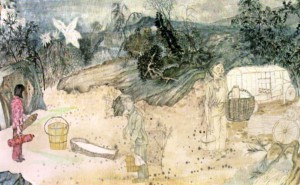THE EMPTY CITY
The Empty City, featuring the work of Yun-Fei Ji, was organized by the Contemporary Art Museum St. Louis and curated by Shannon Fitzgerald.
The exhibition was on display June 4, 2004 – August 15, 2004.
Support for the exhibition was provided by the National Endowment for the Arts, the Regional Arts Commission St. Louis and the Arts & Education Council.
BOOKS AT PROVISIONS
Globalization and Cultural Trends in China
Liu Kang
A critical study on globalization and cultural trends in post-revolutionary China.
One China, Many Paths
Chaohua Wang, ed.
The opinions of economists, historians, philosophers, and writers on modern China are expressed within the pages of this collection.
Before the Deluge: The Vanishing World of the Yangtze’s Three Gorges
Deirdre Chetham
Before the Deluge captures a sense of the daily life, traditions, and history of the people who lived along the upper Yangtze’s Three Gorges area.
Ecocities: Building Cities in Balance With Nature
Richard Register
An architectural outline in which cities minimize their destructive impact on the environment but instead participate in a symbiotic relationship.
Silenced Rivers: The Ecology and Politics of Large Dams
Patrick McCully
The updated version of McCully’s original investigation into the Three Gorges Dam; includes ecological impact, human consequences, safety and technical violations.
The River Dragon Has Come!: The Three Gorges Dam and the Fate of China’s Yangtze River and Its People
Dai Qing
A collection of fifteen essays illustrating Qing’s opposition toward the Three Gorges Dam; an opinion he was imprisoned for by the Chinese government.
Dragon Bones: A Red Princess Mystery
Lisa See
The Yangze River is the backdrop for See’s fictional mystery novel which she uses as a conduit of information regarding the politics and culture of contemporary China.
ARTICLES
The Big Dam Debate and the Three Gorges Project
Susan Murcott, ed.
Special Issue of Boston Society of Civil Engineers: Civil Engineering Practice, 12:1, 1997.
This periodical covers the debate surrounding the Three Gorges Dam and China’s need for the
massive amount of hydro-electric power.
The Three Gorges Dam in China: Forced Resettlement, Suppression of Dissent and Labor Rights Concerns
Published by Human Rights Watch, 1995
Human Rights Watch/Asia calls on Chinese and foreign governments to provide crucial information regarding the resettlement of those affected by the Three Gorges Dam and allow those people to express their opinions through conferences with authorities.
WEBSITES
Embassy of the People’s Republic of China
The Chinese government’s perspective on the Three Gorges Dam project along with several articles detailing the step by step process of construction, defense of resettlement, and response a to environmental damage accusations.
Three Gorges Probe
Includes updated news reports on the Three Gorges Dam, in addition to a photo gallery of the area and background information.
Union of Concerned Scientists
The Union of Concerned Scientists maintain this site which features articles revealing the use of hydro-energy: yet how the Three Gorges Dam project will cause more environmental harm than good.
International Rivers Network
The International Rivers Network lists the environmental concerns, human rights violations, and the environmental impact of commercializing the Yangtze River.
Pilot Destination Guide: People and Politics of the Three Gorges Dam
An internet travel guide entailing the history and the controversy surrounding the Three Gorges Dam.
American University’s Trade and Environmental Database: Case Study on the Three Gorges Dam
A straightforward case study reflecting the general consequences of the Three Gorges Dam and includes a link to similar dam case studies.
The Online NewsHour Transcript: October 8, 1997
Interview with National Geographic’s Spencer Michel discussing the social ramifications of the Three Gorges Dam.
EDUCATION
The Discovery Channel: Three Gorges Lesson Plan
A resource for educators of grades 6-8 with goals of teaching teens about the Three Gorges Dam.
NASA’s Earth Observatory
An orbital image acquired on July 17, 2000 from NASA’s Terra satellite of the Yangtze River and the Xiling Gorge.Three Gorges Dam
Case Study – McGill University
McGill University provides three archeological case studies including the Three Gorges Dam; highlighting the relocation, environmental, and human rights issues.
Posted 2001
NEWS
China’s Three Gorges Dam Fills
June 2, 2003, DiscoveryNews.com
Washington Post: The Yangtze Dam: Feat or Folly?
November 9, 1997, The Washington Post
ART
Chinese Propaganda Posters
Michael Wolf
Taschen Publishing, 2003
Too Much Flavour
Gu Zhenqing, ed.
Chambers Fine Art/New Art Media LTD, 2003
Hong Kong Art: Culture and Decolonization
David Clarke
Duke University Press, 2002
Transience: Chinese Experimental Art at the End of the Twentieth Century
Compiled by Wu Hung, The David and Alfred Smart Museum of Art, 1999
Illustrated Catalog of the Cultural Relics Unearthed From the Dam Area of the Three Gorges
Wang Xiaotian and Wang Fengzhu, eds.
Science Press, 1997
Tales From the Land of Dragons: 1,000 Years of Chinese Painting
Compiled by W.U.Tung, MFA Publications, 1997
Treasure of Asia: Collection of Chinese Paintings
Collection Planned by Albert Skira, Rizzoli International Publications, 1977
FILMS
Yong yuan de San Xia, The Immortal Three Gorges
Changle Liu and Xian Du, 2003
A Million on the Move
Siu-ching Yuan, Dikky Sinn and Diana Lin, 2002
China is Changing Series
Deborah Isaacs, Viviana Fain-Binda and Su-lin Looi, 2000
China’s Great Dam, Taming the Dragon
Monte Markham and Lee Fulkerson, 2000
Three Gorges: The Biggest Dam in the World
Discovery Channel Video, 1998
Yangtze, la Nueva China y el Viejo Rio (Yangtze, New China and the Old River)
Pedro Molina Temboury, 1999
Large Dam, False Promises
David Phinney and Andrea Torrice, 1993


